The Magic Flute has never lost its enchantment since it was first premiered in a small theatre in Vienna in 1791, three months before Mozart’s death, leaving this masterpiece for directors and conductors to explore. As Richard Wigmore points out in the programme notes, “the Magic Flute is the most heterogeneous opera in the repertoire. Its series of short scenes juxtaposes pantomime and Masonic ritual, solemn fairy tale and earthy Viennese humour with a corresponding range of musical idioms”. This potpourri makes the opera difficult to stage satisfactorily.
Simon McBurney’s direction has risen to the challenge with considerable success. Scenes unfold seamlessly so that the central plot of the search for true love by a royal prince, Tamino endowed with a magic flute, and a humble bird-catcher, Papageno, sustains its dramatic edge against a backdrop of a cosmic clash between the dignified Sarastro and the scheming Queen of the Night.
The dark stage sets designed by Michael Levine and clever futuristic lighting effects devised by Jean Kalman heighten the ethereal qualities of this sublime work. Stephen Jeffreys’ free translation of the libretto is pleasantly colloquial and updates the archaic German prose. The large orchestra, which includes some early instruments, is on top form under the baton of Mark Wigglesworth, the ENO Music Director. A particularly ingenious touch in McBurney’s direction is to bring the flautist, Claire Wickes, out from the orchestra to the stage to play Tamino’s magic flute. The celeste player is also made to interact with the stage character Papageno and his magic chimes, adding to the theatricality and humour of the scene.
The principal singers mostly live up to expectations, and their acting is rarely less than superlative. Ambur Braid, as Queen of the Night, is unexpectedly made anorexic and wheelchair-bound. She is set against a bare and soulless backdrop, symbolic of disfigured evil, which could triumph if not countered. While Braid handles her coloratura score competently and negotiates the high notes quite adequately, her voice has insufficient timbre. The tenor, Allan Clayton as Tamino sustains his yearning quest for love with some fine singing. James Creswell plays the role of Sarastro well, but his bass ought to have been lower in pitch to enhance the gravitas that is needed to assume. The British soprano, Lucy Crowe is radiant as Pamina, the Daughter of the Queen of the Night, who was abducted by Sarastro. Her singing is divine. The choral performances are excellent and well synchronised. The three spirits are ambiguously characterisation as geriatrics or emaciated youths. Their puny frames, like that of the Queen of the Night in this production, seem to allude to the frailty of the human condition.
The flapping of white sheets of paper to conjure birds in flight is very clever, as is the use of stunning video projections and sound effects to render trials by the elements of fire and water, to give just some examples. The device of a business meeting around a table to represent the lead up to the decision by Sarastro and dutifully followed by his acolytes regarding the fate of the lovers Tamino and Pamina is another adroit idea. The main let down of this production is the costume department. There is a tendency to informal modern dress. Poor Peter Coleman-Wright, in the role of Papageno, is made to prance around in high-viz workman’s vest, dragging a cheap aluminium ladder around with him. He only lacks a hard hat to be mistaken for a gas repairman.
Considered overall, this production makes for an enjoyable aural and visual experience and a memorable evening at the opera.







